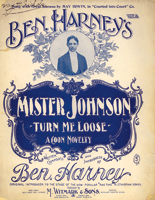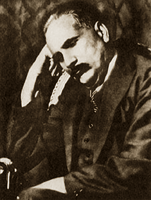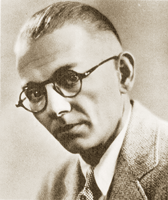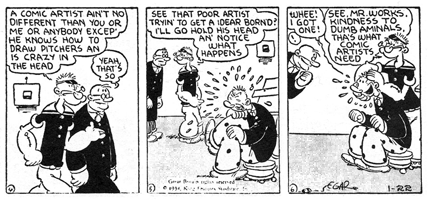
Welcome to the Public Domain
By Miriam Phillips
Jurisdictions with a 70-year period of post-mortem copyright protection will be welcoming into the public domain this year a wealth of works from authors, artists and musicians who died in 1938*. This selection was compiled once again (see WIPO Magazine 1/2008) by Miriam Phillips, a student of music at Cambridge University, UK, for the IPKat weblog.
C.J. Dennis (1876-1938). Australia’s Clarence James Dennis published his first poem at the age of 19. His most famous work, The Sentimental Bloke, sold 65,000 copies in its first year of publication (1916). The Songs of a Sentimental Bloke, one of numerous spin-off publications, describes the day-to-day adventures of a man, his girl Doreen and friend Ginger Mick. The Sentimental Bloke was adapted as a stage play, silent movie, sound movie and musical; the title character even featured on a series of Australian stamps in the 1980s.

Ben Harney (1872-1938).
A musician, songwriter and pioneer of ragtime music,
born in Tennessee, Benjamin Robertson “Ben” Harney’s early
songs were great hits and the sheet music of “Cake Walk in the Sky”
is the first written example of vocal ragging. In 1897, Ben Harney’s
Rag Time Instructor was published, giving the first description of how
to improvise ragtime music by syncopating popular tunes.
In 1924, the New York Times wrote that Ben Harney "probably did
more to popularize ragtime than any other person."

Sir Muhammed Iqbal (1877-1938).
Born in what is now Pakistan into a deeply religious family, Muhammed Iqbal travelled and studied
widely, obtaining qualifications in philosophy, English literature, Arabic and law from various
institutions in Europe. Widely referred to as Allama (‘the scholar’) Iqbal, his Urdu and Persian
poetry is regarded among the greatest of the modern era, and the anniversary of his birth is marked
as a national holiday in Pakistan to this day.
Sir Henry Newbolt (1862-1938). The Englishman Henry Newbolt graduated from Oxford and practised law until 1899. He published his first novels in the early 1890s, but his literary reputation was not established until the publication of Admirals All, a set of ballads produced in 1897. The best known of these is “Vitaï Lampada,” a ballad about a future soldier who learns stoicism from playing cricket. The poem was highly regarded during the First World War, but became heavily satirized by soldiers returning from the Western Front. The poet was knighted in 1915, and awarded the ‘Companion of Honour’ seven years later.
Grey Owl (1888-1938). Born in England and brought up in Hastings by his grandmother and aunts, Archibald Belaney left school at 16 and moved to Canada. Once there, he changed his identity to that of “Grey Owl,” telling people he was the son of an Apache woman and had emigrated from the US to join the Ojibwa. After several years working as a wilderness guide and forest ranger, Grey Owl started to publish his writings about wilderness life, which promoted environmentalism and nature conservation. Grey Owl even toured England in Ojibwa costume to publicize his works and lecture on conservationism. His aunts recognized him but chose to remain silent. It was only after his death in 1938 that doubts arose over his native-American identity. Discovery of his deceit led to the withdrawal of some of his books from publication and disillusionment with his conservationist causes.


E.C. Segar (1894-1938).
American cartoonist Elzie Crisler Segar, creator of “Popeye the Sailor,” was determined to make his way as a cartoonist. At the age of 18 he invested US$20 in a correspondence course in cartooning and, after day’s work as a film projectionist, he would “light the oil lamps” and immerse himself in his course until the early hours of the morning. His first comic, “Charlie Chaplin’s Comedy Capers,” was published in 1916. He moved east to work for the New York Journal, drawing “Thimble Theatre.” The strip featured Olive Oyl, Castor Oyl and Ham Gravy. It was not for another 10 years, in 1929, that the enormously popular Popeye joined their ranks. After Segar’s early death at the age of 43, his assistant Bud Sagendorf continued to produce the comic.
Kasym Tynystanov (1901-1938). At the time of Kasym Tynystanov’s birth, the level of literacy among Kyrgyz nomads was approximately two percent and the Kyrgyz people had no written language, but he learned to read and write Arabic from his father. Following the Soviet Revolution, he sought further education in Almaty. While still studying in Tashkent, he started to develop the first Kyrgyz alphabet. His poetry and prose began to appear in Kazakh newspapers, printed in his new Kyrgyz script, and his songs became very popular with Kyrgyz youth. In 1924, after the approval of the new alphabet, he created the first Kyrgyz readers for primary schools. Some 90 percent of the terminology created by Kasym is still in use today. He became the first Kyrgyz Minister for Education and established the country’s education system.
César Vallejo (1892-1938). César Vallejo published only three books of poetry, but he is considered one of the influential poets of the 20th century. One of 11 children, he was born in a village in the Peruvian Andes. The exploitation of agrarian workers that Vallejo witnessed while working on a sugar plantation, greatly impacted his political views. In 1916, he moved to Lima where he worked as a schoolteacher and met the artistic and political vanguard. He first poetry collection was published in 1919. But the years that followed were disastrous: he had an affair, lost his job, his mother died and he served a short prison term. When he emerged in 1922, he produced Trilce, which remains one of the most radically avant-garde collections in Spanish literature. Influenced by the Spanish Civil War, his last burst of poetic activity came in the late 1930s.
Wang Zhen (1867-1938). Wang Zhen, a modern Chinese artist of the Shanghai school, was a close disciple of the painter Wu Changshuo, who became his mentor. Some even claim that certain paintings attributed to Wu Changshuo are actually by Wang Zhen. Wang Zhen spent most of his life in Shanghai. He was an expert calligrapher as well as a painter. He specialized in portraying flowers, birds and Buddhist subjects. Wang Zhen’s paintings were particularly popular in Japan, where he had greater success than among his compatriots.
Zitkala-Sa (d.1938). Zitkala-Sa, which translates as Red Bird, was a Native American writer, editor, musician, teacher and political activist. She was raised in South Dakota on the Yankton Sioux Reservation until the age of eight when she was removed from the Reservation to attend a boarding school in Indiana. After studying at the Boston Conservatory of Music, Zitkala-Sa composed the first American-Indian grand opera, The Sun Dance, in 1913. While working as a teacher in Boston, she began to publish short stories and autobiographical anecdotes that were serialized and later published in a collection called American Indian Stories. In her later years, Zitkala-Sa’s works were more political. She published monthly articles and a number of books depicting the hardships of being forced to leave home for boarding school, and the alienation she felt in both worlds.
* The term of copyright protection can be affected by other rules in various countries. In some countries, for example, the term has been temporarily prolonged because works could not be exploited during wartime. The term will also be longer for works co-authored with another person whose term of protection has not yet expired. It is advisable always to check carefully the status of a work in light of the applicable national legislation before using it without authorization.
The WIPO Magazine is intended to help broaden public understanding of intellectual property and of WIPO’s work, and is not an official document of WIPO. The designations employed and the presentation of material throughout this publication do not imply the expression of any opinion whatsoever on the part of WIPO concerning the legal status of any country, territory or area or of its authorities, or concerning the delimitation of its frontiers or boundaries. This publication is not intended to reflect the views of the Member States or the WIPO Secretariat. The mention of specific companies or products of manufacturers does not imply that they are endorsed or recommended by WIPO in preference to others of a similar nature that are not mentioned.